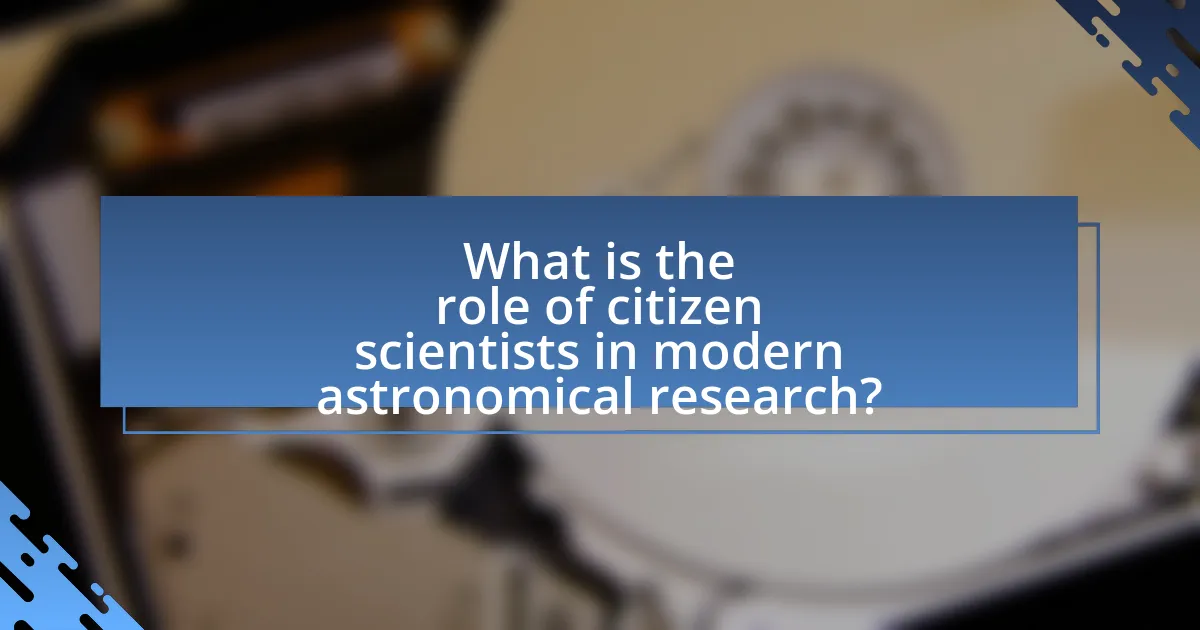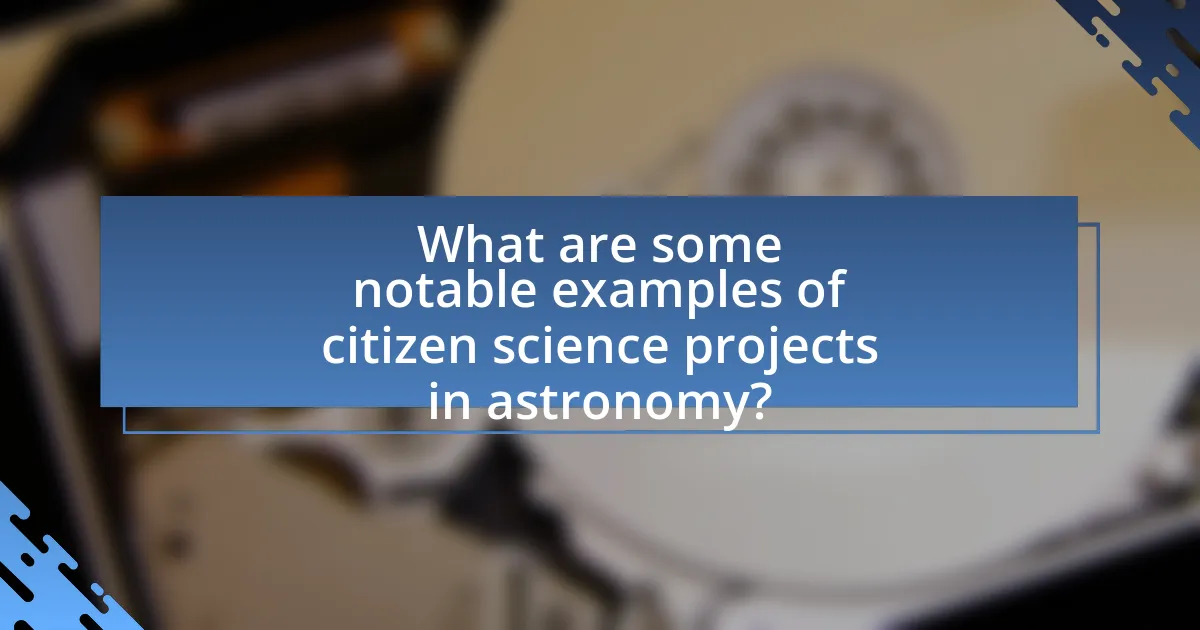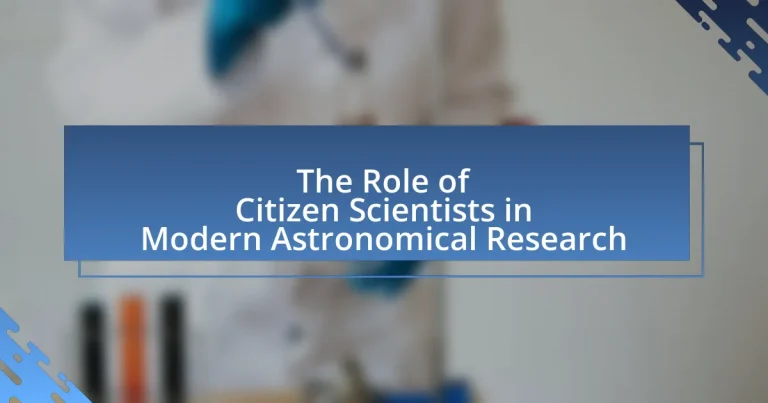Citizen scientists are integral to modern astronomical research, significantly contributing to data collection, analysis, and discovery. Through initiatives like Galaxy Zoo, volunteers classify galaxies and identify celestial phenomena, leading to advancements in our understanding of the universe. This article explores the various roles and tasks of citizen scientists, their collaboration with professional astronomers, the challenges they face, and the impact of their contributions on astronomical knowledge. Additionally, it highlights successful citizen science projects and provides insights into how individuals can engage in this field, emphasizing the importance of training and resources for effective participation.

What is the role of citizen scientists in modern astronomical research?
Citizen scientists play a crucial role in modern astronomical research by contributing data collection, analysis, and discovery efforts that enhance scientific understanding. They participate in projects such as the Galaxy Zoo, where volunteers classify galaxies, leading to significant findings about galaxy formation and evolution. Research indicates that citizen scientists have contributed to the discovery of new astronomical phenomena, including supernovae and exoplanets, demonstrating their impact on advancing the field. Their involvement not only accelerates data processing but also fosters public engagement and education in science, making astronomy more accessible to a broader audience.
How do citizen scientists contribute to astronomical discoveries?
Citizen scientists contribute to astronomical discoveries by analyzing vast amounts of data that professional astronomers cannot process alone. For example, projects like Galaxy Zoo allow volunteers to classify millions of galaxies, leading to the identification of new galaxy types and structures. This collaborative effort has resulted in significant findings, such as the discovery of the first known example of a galaxy with a double nucleus, showcasing the impact of citizen involvement in advancing astronomical knowledge.
What specific tasks do citizen scientists perform in research projects?
Citizen scientists perform a variety of specific tasks in research projects, including data collection, data analysis, and observation reporting. For instance, in astronomical research, they often contribute by classifying celestial objects, monitoring variable stars, and identifying exoplanets through light curve analysis. These contributions are validated by platforms like Galaxy Zoo, where citizen classifications have been shown to match professional astronomers’ assessments, demonstrating the reliability of their input. Additionally, citizen scientists may engage in outreach and education, helping to disseminate scientific knowledge to the public, which further enhances the research community’s engagement with broader audiences.
How do citizen scientists collaborate with professional astronomers?
Citizen scientists collaborate with professional astronomers by participating in data collection, analysis, and interpretation of astronomical phenomena. This collaboration often occurs through structured projects where citizen scientists contribute observations, such as identifying celestial objects or classifying galaxies, using online platforms and tools provided by professional institutions. For example, projects like Galaxy Zoo have successfully engaged thousands of volunteers in classifying millions of galaxy images, significantly accelerating research that would take professionals much longer to complete alone. This partnership enhances the research capabilities of professional astronomers by leveraging the collective efforts and diverse perspectives of the public, leading to discoveries and advancements in the field of astronomy.
Why is citizen science important in the field of astronomy?
Citizen science is important in the field of astronomy because it significantly enhances data collection and analysis capabilities. By involving non-professional astronomers, large-scale projects like Galaxy Zoo have successfully classified millions of galaxies, contributing to our understanding of cosmic structures. This collaborative approach not only accelerates research but also democratizes science, allowing diverse participation and fostering public interest in astronomy. Studies indicate that citizen scientists can match or even exceed the accuracy of professional astronomers in specific tasks, demonstrating their valuable role in advancing astronomical knowledge.
What advantages do citizen scientists bring to astronomical research?
Citizen scientists significantly enhance astronomical research by increasing data collection and analysis capabilities. They contribute to large-scale projects, such as the Galaxy Zoo initiative, where volunteers classify millions of galaxies, thereby accelerating the pace of research. This collective effort allows professional astronomers to focus on more complex analyses and theoretical work. Additionally, citizen scientists often bring diverse perspectives and innovative approaches to problem-solving, which can lead to new discoveries. Their involvement has been shown to lead to the identification of transient astronomical events, such as supernovae, which might otherwise go unnoticed.
How does citizen science enhance public engagement with astronomy?
Citizen science enhances public engagement with astronomy by actively involving non-professionals in data collection and analysis, fostering a sense of community and shared purpose. Programs like Galaxy Zoo allow participants to classify galaxies, which not only contributes to scientific research but also educates them about astronomical concepts. Research indicates that citizen science projects can increase public interest in science; for example, a study published in the journal “Public Understanding of Science” found that participants in citizen science initiatives reported higher levels of interest in astronomy and science-related activities. This engagement leads to a more informed public and encourages ongoing participation in scientific endeavors.

What are the challenges faced by citizen scientists in astronomical research?
Citizen scientists in astronomical research face several challenges, including limited access to advanced technology, lack of formal training, and difficulties in data validation. Limited access to sophisticated telescopes and software restricts their ability to conduct high-quality observations. Additionally, many citizen scientists lack formal education in astronomy, which can hinder their understanding of complex concepts and methodologies. Data validation poses another significant challenge, as citizen scientists must ensure the accuracy of their findings amidst vast amounts of data, often requiring collaboration with professional astronomers to confirm results. These challenges highlight the need for better resources and support systems to enhance the contributions of citizen scientists in the field.
What obstacles do citizen scientists encounter in data collection?
Citizen scientists encounter several obstacles in data collection, including lack of training, limited access to resources, and difficulties in data validation. The absence of formal training can lead to inconsistent data quality, as volunteers may not fully understand the scientific methods required for accurate observations. Limited access to necessary tools, such as telescopes or software, can hinder their ability to collect comprehensive data. Additionally, challenges in validating the data collected arise from the need for expert review, which can be time-consuming and may not always be available, leading to potential inaccuracies in the findings.
How can technology improve the data collection process for citizen scientists?
Technology can significantly enhance the data collection process for citizen scientists by providing advanced tools and platforms that streamline data gathering and analysis. For instance, mobile applications enable users to easily record observations and upload data in real-time, which increases the accuracy and timeliness of information collected. Additionally, cloud-based databases allow for efficient storage and sharing of large datasets, facilitating collaboration among citizen scientists and researchers. A study by the National Academies of Sciences, Engineering, and Medicine in 2018 highlighted that the integration of technology in citizen science projects leads to improved data quality and greater participant engagement, demonstrating the effectiveness of these technological advancements in enhancing the overall data collection process.
What training or resources do citizen scientists need to overcome these challenges?
Citizen scientists need structured training programs and access to online resources to effectively overcome challenges in modern astronomical research. Training programs should focus on data collection techniques, observational skills, and the use of specific astronomical tools and software. Online resources, such as tutorials, webinars, and community forums, provide essential support and knowledge sharing among citizen scientists. For instance, platforms like Zooniverse offer guided projects that help participants learn how to classify astronomical data accurately. This combination of training and resources enhances the ability of citizen scientists to contribute meaningfully to research initiatives.
How do citizen scientists ensure the quality of their contributions?
Citizen scientists ensure the quality of their contributions through rigorous training, standardized protocols, and peer review processes. They often participate in structured programs that provide educational resources and guidelines on data collection and analysis, which helps maintain consistency and accuracy. For example, platforms like Galaxy Zoo offer tutorials and feedback mechanisms that enhance the reliability of classifications made by volunteers. Additionally, many citizen science projects implement validation steps where expert scientists review and verify the contributions, ensuring that the data meets scientific standards. This combination of training, adherence to protocols, and expert oversight collectively enhances the credibility and quality of citizen scientists’ contributions to astronomical research.
What methods are used to validate the findings of citizen scientists?
The findings of citizen scientists are validated through several methods, including peer review, cross-validation with professional data, and the use of established protocols. Peer review involves experts evaluating the citizen scientists’ data and methodologies to ensure accuracy and reliability. Cross-validation occurs when citizen-generated data is compared against data collected by professional astronomers or other authoritative sources, confirming consistency and correctness. Established protocols provide guidelines for data collection and analysis, ensuring that citizen scientists adhere to scientific standards, which enhances the credibility of their findings. These methods collectively reinforce the validity of contributions made by citizen scientists in astronomical research.
How do citizen scientists communicate their results to the scientific community?
Citizen scientists communicate their results to the scientific community primarily through online platforms, peer-reviewed journals, and collaborative projects. These individuals often utilize dedicated websites and databases, such as Zooniverse or Galaxy Zoo, to share their findings and contribute to ongoing research. Additionally, citizen scientists may present their results at conferences or workshops, fostering direct interaction with professional researchers. The integration of citizen-generated data into scientific studies has been validated by numerous publications, demonstrating the reliability and significance of their contributions, such as the study published in the journal “Nature” by Lintott et al. (2011), which highlighted the impact of citizen science on astronomical research.

What are some notable examples of citizen science projects in astronomy?
Notable examples of citizen science projects in astronomy include Galaxy Zoo, Zooniverse, and the Planet Hunters initiative. Galaxy Zoo, launched in 2007, allows volunteers to classify galaxies based on their shapes, contributing to the understanding of galaxy formation and evolution. Zooniverse encompasses various projects, enabling participants to analyze data from different astronomical surveys, such as identifying exoplanets or classifying celestial objects. Planet Hunters, specifically focused on detecting exoplanets, invites citizen scientists to examine light curves from stars to identify potential planetary transits. These projects have collectively led to significant discoveries, including the identification of thousands of new galaxies and exoplanets, demonstrating the impactful role of citizen scientists in advancing astronomical research.
What are the most successful citizen science initiatives in astronomy?
The most successful citizen science initiatives in astronomy include Galaxy Zoo, Zooniverse, and SETI@home. Galaxy Zoo, launched in 2007, allows volunteers to classify galaxies based on their shapes, contributing to significant discoveries such as the identification of new galaxy types. Zooniverse, a broader platform, hosts various projects including the classification of celestial objects and the analysis of astronomical data, engaging thousands of volunteers. SETI@home, initiated in 1999, enables participants to analyze radio signals from space in the search for extraterrestrial intelligence, utilizing distributed computing to process vast amounts of data. These initiatives have collectively advanced astronomical research by harnessing the power of public participation and have led to numerous scientific publications and discoveries.
How have these projects impacted our understanding of the universe?
Citizen science projects have significantly enhanced our understanding of the universe by enabling large-scale data collection and analysis that would be impossible for professional astronomers alone. For instance, projects like Galaxy Zoo have allowed volunteers to classify millions of galaxies, leading to discoveries about galaxy formation and evolution. Additionally, the contributions of citizen scientists in monitoring variable stars and detecting exoplanets have expanded our knowledge of stellar behavior and planetary systems. These collaborative efforts have resulted in numerous scientific publications, demonstrating the value of public participation in advancing astronomical research.
What lessons can be learned from these successful initiatives?
Successful initiatives in citizen science demonstrate the importance of collaboration, accessibility, and community engagement. These initiatives show that involving non-professionals can significantly enhance data collection and analysis, as evidenced by projects like Galaxy Zoo, which utilized over 100,000 volunteers to classify galaxies, resulting in valuable scientific insights published in peer-reviewed journals. Furthermore, these projects highlight the necessity of providing clear instructions and user-friendly platforms to maximize participation and data quality. The success of these initiatives underscores the potential for citizen scientists to contribute meaningfully to research, fostering a sense of ownership and interest in scientific endeavors.
How can individuals get involved in citizen science in astronomy?
Individuals can get involved in citizen science in astronomy by participating in projects that allow them to contribute data, analyze astronomical images, or engage in public outreach. Numerous platforms, such as Zooniverse and Galaxy Zoo, offer opportunities for volunteers to classify galaxies, identify exoplanets, or track variable stars. These projects often rely on contributions from non-professionals, demonstrating that citizen scientists can significantly enhance astronomical research. For example, Galaxy Zoo has engaged over 100,000 volunteers, leading to the classification of millions of galaxies, showcasing the impact of citizen involvement in advancing our understanding of the universe.
What platforms or organizations support citizen scientists in astronomy?
Organizations that support citizen scientists in astronomy include Zooniverse, NASA’s Citizen Science program, and the American Association of Variable Star Observers (AAVSO). Zooniverse provides a platform for various astronomy projects where volunteers can classify galaxies and identify exoplanets. NASA’s Citizen Science program engages the public in data collection and analysis for projects like the Solar System Ambassadors program. AAVSO offers resources and training for amateur astronomers to contribute to variable star research, facilitating collaboration between professional and citizen scientists. These organizations enhance public participation in astronomical research, fostering a community of engaged citizen scientists.
What skills or knowledge should aspiring citizen scientists develop?
Aspiring citizen scientists should develop skills in data collection, analysis, and communication. Proficiency in using scientific tools and software for data analysis is essential, as citizen scientists often contribute to large datasets in fields like astronomy. Familiarity with scientific methods and principles enhances their ability to conduct research effectively. Additionally, strong communication skills are necessary for sharing findings with the scientific community and the public. Research indicates that citizen scientists who engage in training programs show improved data accuracy and project outcomes, highlighting the importance of these skills in contributing to modern astronomical research.
What best practices should citizen scientists follow for effective research?
Citizen scientists should follow structured methodologies, maintain accurate data collection, and engage in continuous learning for effective research. Structured methodologies, such as using standardized protocols, ensure consistency and reliability in observations. Accurate data collection involves meticulous recording of findings, which is crucial for validating results; for instance, the Galaxy Zoo project emphasizes the importance of precise classifications in galaxy morphology. Continuous learning through workshops and online courses enhances skills and knowledge, enabling citizen scientists to contribute meaningfully to research initiatives.

